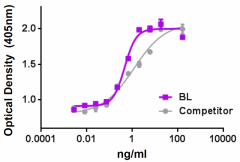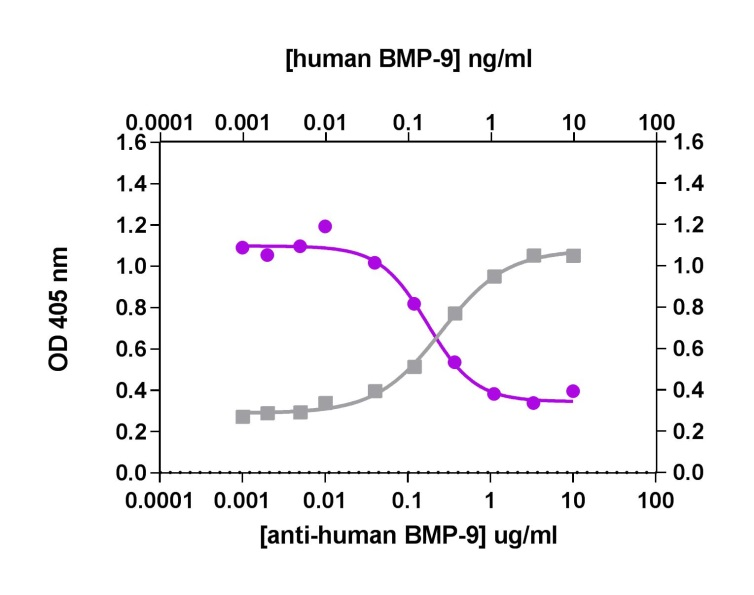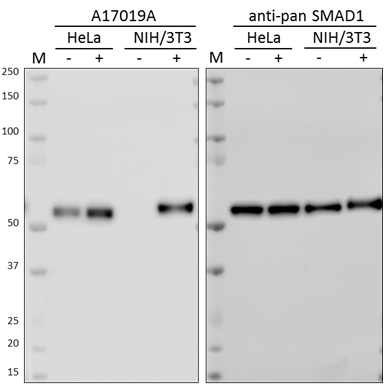- Regulatory Status
- RUO
- Other Names
- Bone morphogenetic protein 9 (BMP9), Growth/differentiation factor 2 (GDF2)
- Ave. Rating
- Submit a Review
- Product Citations
- publications

-

Recombinant human BMP-9 induces the production of alkaline phosphatase in the embryonal carcinoma-derived chondrogenic ATDC5 cell line in a dose dependent manner. BioLegend’s protein was compared side-by-side to the leading competitor’s equivalent product.
| Cat # | Size | Price | Quantity Check Availability | Save | ||
|---|---|---|---|---|---|---|
| 553102 | 10 µg | 175€ | ||||
| 553104 | 25 µg | 278€ | ||||
BMP-9 was initially isolated from fetal mouse liver cDNA libraries. The mouse and human proteins share 84% identity. They are part of the bone morphogenetic protein (BMP) family of proteins, which are members of the TGF-β superfamily and play a key role in skeletal development, bone formation, and stem cell differentiation. BMP-9 is one of the most osteogenic factors of the family. It is synthetized by hepatocytes and intrahepatic biliary epithelial cells. It circulates in plasma in an unprocessed, inactive form, that can be further activated by furin as well as a mature and fully active complex form bound to its prodomain. BMPs signal through heterotetrameric complex receptors, which include four type I receptors (ALK-1, ALK-2, ALK-3, and ALK-6) and three type II receptors (BMPRII, ActRIIA, and ActRIIB). BMP-9 and BMP-10 bind to ALK-1 (mainly expressed in endothelial cells). BMP-9 inhibits the proliferation of endothelial cells induced by basic FGF and VEGF-stimulated angiogenesis by binding to ALK-1. BMP-9 also binds to ALK-2 in primary myeloma cells, and this binding can be inhibited by membrane-bound or soluble endoglin (an accessory receptor for the TGF-β family). BMP-9 activity is inhibited by crossveinless-2 (CV2), a member of the chordin family and an extracellular regulator. BMP-9 induces CV2 expression in endothelial cells and in a negative feedback loop inhibits its own activity by the binding of CV2 to BMP-9, which consequently inhibits its binding to ALK-1. BMP-9 and -10 possess tumor suppressing activity in breast and prostate cancer; BMP-9 also induces apoptosis in primary myeloma cells. In contrast, autocrine BMP-9 signaling induces proliferation of ovarian and liver cancer cells.
Product DetailsProduct Details
- Source
- Human BMP-9, amino acids (Ser320 - Arg429) (Accession# NM_016204), was expressed in CHO cells.
- Molecular Mass
- The 110 amino acid recombinant protein has a predicted molecular mass of approximately 12 kD. The DTT-reduced and non-reduced protein migrate at approximately 14 kD and 24 kD respectively by SDS-PAGE. The predicted N-terminal amino acid is Ser.
- Purity
- >95%, as determined by Coomassie stained SDS-PAGE.
- Formulation
- 0.22 µm filtered protein solution is in 30% Acetonitrile, 0.1% TFA (trifluoroacetic acid).
- Endotoxin Level
- Less than 0.01 ng per µg cytokine as determined by the LAL method.
- Concentration
- 10 and 25 µg sizes are bottled at 200 µg/mL.
- Storage & Handling
- Unopened vial can be stored between 2°C and 8°C for up to 2 weeks, at -20°C for up to six months, or at -70°C or colder until the expiration date. For maximum results, quick spin vial prior to opening. The protein can be aliquoted and stored at -20°C or colder. Stock solutions can also be prepared at 50 - 100 µg/mL in appropriate sterile buffer, carrier protein such as 0.2 - 1% BSA or HSA can be added when preparing the stock solution. Aliquots can be stored between 2°C and 8°C for up to one week and stored at -20°C or colder for up to 3 months. Avoid repeated freeze/thaw cycles.
- Activity
- ED50 = 0.4 - 2 ng/ml, corresponding to a specific activity of 0.5 - 2.5 x 106 units/mg, as determined by induction of alkaline phosphatase in ATDC5 cells in a dose dependent manner.
- Application
-
Bioassay
- Application Notes
-
BioLegend carrier-free recombinant proteins provided in liquid format are shipped on blue-ice. Our comparison testing data indicates that when handled and stored as recommended, the liquid format has equal or better stability and shelf-life compared to commercially available lyophilized proteins after reconstitution. Our liquid proteins are verified in-house to maintain activity after shipping on blue ice and are backed by our 100% satisfaction guarantee. If you have any concerns, contact us at tech@biolegend.com.
- Product Citations
-
Antigen Details
- Structure
- Homodimer
- Distribution
-
Hepatocytes, non parenchimal cells of the liver, endothelial, stellate cells, osteosarcoma cells.
- Function
- Induces osteogenesis, chondrogenesis, and differentiation of cholinergic neurons, regulates glucose metabolism.
- Interaction
- Endothelial cells, microvascular endothelial cells, prostate cancer cells, ovarian cancer cells, osteosarcoma cells, primary myeloma cells.
- Ligand/Receptor
- Activin receptor-like kinase- ALK-1 and ALK-5 in endothelial cells; ALK-1 and BMPR-II in endothelial cells; ALK-1 and ALK-2 in mesenchymal stem cells; ALK-2 and BMPR-II in myoblasts; ALK-1 and endoglin in glioblastoma cells. Endoglin (CD105).
- Bioactivity
- Induction of alkaline phosphatase in ATDC5 cells.
- Cell Type
- Embryonic Stem Cells, Hematopoietic stem and progenitors, Mesenchymal Stem Cells, Neural Stem Cells
- Biology Area
- Cell Biology, Neuroscience, Stem Cells, Synaptic Biology
- Molecular Family
- Cytokines/Chemokines, Growth Factors
- Antigen References
-
1. Miller AF, et al. 2000. J. Bio. Chem. 275:17937.
2. Chen C, et al. 2003. Nat. Biotechnol. 21:294.
3. Scharpfenecker M, et al. 2007. J. Cell Sciences 120:964.
4. Luo J, et al. 2010. J. Biol. Chem. 285:29588.
5. Bidart M, et al. 2012. Cell Mol. Life Sci. 69:313-24.
6. Yao Y, et al. 2012. Blood 119:5037.
7. Olsen OE, et al. 2014. Blood Cancer J. 4:e196.
8. Herrera B, et al. 2014. Int. J. Mol. Sci. 15:5199. - Gene ID
- 2658 View all products for this Gene ID
- UniProt
- View information about BMP-9 on UniProt.org
Related FAQs
- Why choose BioLegend recombinant proteins?
-
• Each lot of product is quality-tested for bioactivity as indicated on the data sheet.
• Greater than 95% Purity or higher, tested on every lot of product.
• 100% Satisfaction Guarantee for quality performance, stability, and consistency.
• Ready-to-use liquid format saves time and reduces challenges associated with reconstitution.
• Bulk and customization available. Contact us.
• Learn more about our Recombinant Proteins. - How does the activity of your recombinant proteins compare to competitors?
-
We quality control each and every lot of recombinant protein. Not only do we check its bioactivity, but we also compare it against other commercially available recombinant proteins. We make sure each recombinant protein’s activity is at least as good as or better than the competition’s. In order to provide you with the best possible product, we ensure that our testing process is rigorous and thorough. If you’re curious and eager to make the switch to BioLegend recombinants, contact your sales representative today!
- What is the specific activity or ED50 of my recombinant protein?
-
The specific activity range of the protein is indicated on the product datasheets. Because the exact activity values on a per unit basis can largely fluctuate depending on a number of factors, including the nature of the assay, cell density, age of cells/passage number, culture media used, and end user technique, the specific activity is best defined as a range and we guarantee the specific activity of all our lots will be within the range indicated on the datasheet. Please note this only applies to recombinants labeled for use in bioassays. ELISA standard recombinant proteins are not recommended for bioassay usage as they are not tested for these applications.
- Have your recombinants been tested for stability?
-
Our testing shows that the recombinant proteins are able to withstand room temperature for a week without losing activity. In addition the recombinant proteins were also found to withstand four cycles of freeze and thaw without losing activity.
- Does specific activity of a recombinant protein vary between lots?
-
Specific activity will vary for each lot and for the type of experiment that is done to validate it, but all passed lots will have activity within the established ED50 range for the product and we guarantee that our products will have lot-to-lot consistency. Please conduct an experiment-specific validation to find the optimal ED50 for your system.
- How do you convert activity as an ED50 in ng/ml to a specific activity in Units/mg?
-
Use formula Specific activity (Units/mg) = 10^6/ ED50 (ng/mL)
 Login / Register
Login / Register 














Follow Us